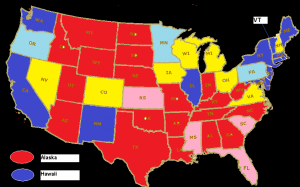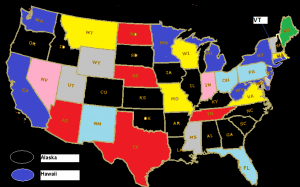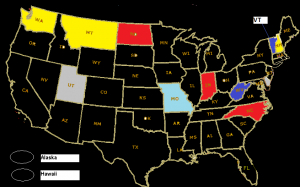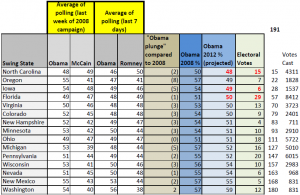Part 1: Summary Statistics (last 7 days)
Obama vs Romney: 48-47% Romney (was 49-47% Romney)
President Obama job approval: 49-49% approve/disapprove (was 49-48% approve/disapprove)
Generic Congressional Vote: 45-45% Republican (was 45-44% Republican)
US Senate Projections: 47 Democrats, 47 Republicans, 1 Independent, 5 Tossups (was 48-46-1 Democrat)
Governor’s Race Projections: 30 Republicans, 16 Democrats, 1 Independent, 3 Tossups (was 30-16-1 Republican)
Part 2: Presidential Scorecard (270 electoral votes required to win): Romney 235, Obama 221, Undecided 82 (prior scorecard: 235-221 Romney)
(Note: blue = safe Democratic, light blue = leans Democratic, yellow = tossup, light red = leans Republicans, red =solid Republican)
The final week of election season got an unusual “October surprise”: Hurricane Sandy, which brought flooding and destruction to parts of the Northeast. However, it’s not apparent that this event has changed the trajectory of the race much. While polls from CBS showed President Obama with leads in three swing states (Florida, Ohio, and Virginia) averaging 49-46%, what was omitted from the reporting was the previous polls conducted several weeks ago by CBS showed Obama with 52-44% leads in those states. In other words, even CBS’ polls showed the Obama margin shrinking – from 8 to 3 points in this example. And these polls have consistently been the most favorable towards President Obama.
Really, the race seems to have reached an equilibrium, and we are only making one change to our scorecard:
- North Carolina: “Leans Republican” to “Solid Republican”
Meanwhile, early voting volume continues to accelerate: the last early voting state (Oklahoma) started its early voting today. However, the pendulum is now swinging the other way: early voting is starting to conclude in the other 29 states that had it (Louisiana’s in person early voting concluded three days ago). Thus far, the official number of votes that have been cast is (as this article is being written) 23 million. Given the time delay for statistics to be reported, we think that number is actually 28-30 million early votes already cast.
Part 3: What does it take for Romney to win?
We would like to independently analyze the Presidential election by using actual polling data from 2008 to provide the proper context for what we are seeing now. In other words, the last 7 days of polling at the statewide level don’t mean much in isolation unless you compare it against polling from the last week of the 2008 campaign. When that analysis is performed, here’s what we see:
If we take the polls in 2008 and 2012 at face value, Mitt Romney has taken a lead in the Electoral College for the first time. We also think that, given the numbers in Iowa relative to 2008 polling, Romney can carry Iowa as well, which will net him 6 more electoral votes. What will it take for him to go from 241 to 270 electoral votes?
To get to 270 electoral votes, there are two states that are too close to call where Romney needs 71K more votes (or 36K Obama votes need to be converted): Colorado and Virginia. To illustrate how tight the race is right now, the total vote cast in 2008 in those two states was 6 million. Carrying those states gets Romney up to 263 electoral votes.
Beyond that, Romney has any one of eight options (technically, seven, since New Hampshire can only get Romney up to 267 electoral votes): Michigan, Minnesota, New Hampshire, Nevada, Ohio, Oregon, Pennsylvania, and Wisconsin. Minnesota and Oregon have to be considered long shots, but Obama is running weaker enough in polls in those states to where a last minute blitz by the Romney campaign could move some votes. Michigan and Pennsylvania are within the realm of possibility, especially considering recent polling there. That leaves Nevada, Ohio, and/or Wisconsin. In all those states, the margin is narrow enough for presumed GOP voter intensity to make up the difference, although in Ohio, early voting has not very favorable for the Republicans so far. Incidentally, winning Nevada would only bring Romney to an electoral vote tie, but in that situation, the election would be thrown into the House of Representatives, which almost certainly will remain in Republican hands.
Part 4: Early Voting Updates (as of November 2)
As this article is being written, early voting totals are rapidly changing (in 9 states, over 1 million early votes have already been cast). What are we seeing so far?
North Carolina: Since early voting started three weeks ago, the voter counts have been rapidly changing. Currently, 2.3 million have early voted (to put this number in perspective, that is already 52% of those who voted in 2008). While Democrats have gotten off to a huge head start (37% of those early voting on the first day were black, while 22% of the registered voters in North Carolina are black), Republicans have begun to play catch up, however, as yesterday’s in person voters were 24% black. Overall, the racial breakdown of early/voters is 68/27% white/black and 48/32% Democrat/Republican (the 2008 early/absentee voters were 67-29% white/black and 54/28% Democrat/Republican). As the Democratic dominance with in person early voting continues to recede, it is likely that President Obama will not get as much of a “bump” from the early voters as he did in 2008 (his getting 56% of the early vote enabled him to carry the state in 2008).
Iowa: Iowa has traditionally had a strong Democratic early vote. In fact, McCain carried the state 50-48% if you were to look only at Election Day voters; early voters supported Obama 60-38%. This time, Democrats got off to a strong start (nearly 70% of the first day’s voters were Democrats). This advantage has continually eroded over time, and a 44-32% Democratic lead from a week ago is now 43-32% Democratic, and 584K early votes have been cast so far. In other words, the partisan breakdown is now 3% more Republican and 3% less Democratic than the 2008 early voters (who were 46-29% Democratic). Furthermore, Republicans (like with North Carolina) tend to vote more on Election Day. The big question for the Republicans is how much further they can keep diluting the initial advantage Democrats had among early voters.
Ohio: While meaningful results remain tough to come by (absentee/early voting data is compiled at the county level, and Ohio has 88 counties), we do know that 1.4 million early votes have been cast. In counties that voted Democratic in 2008 and 2010, 28% of the 2008 vote has already been cast. That figure is 23% in Republican counties and 22% in “swing” counties. It’s also worth noting, however, that data in predominately Democratic Cleveland and Columbus is updated on a daily basis, while in many Republican counties, we are lucky to get weekly updates. Furthermore, in 43 of the counties (representing 31% of the vote), our data is a week old, and McCain got 56% in those counties – 9 points more than his statewide average. Therefore, we think it’s more accurate to say that Democrats have been aggressive getting their vote out, but their advantage is not an overwhelming one. This advantage likely means that we may not know the Ohio results right away on Election Night. In fact, it’s possible the result may not be known for 10 days, due to recent changes in the law: absentee ballot applications are now sent to everyone, and those who turned in their absentee ballot application but later change their mind and want to vote on Election Day will only be allowed to cast a provisional ballot. And provisional ballots are counted 10 days AFTER Election Day.
Florida: In person early voting started a week ago, and a whopping 3.1 million Floridians have early voted. While registered Democrats lead among early voters, it’s a narrow 43-41% lead (for proper context, Democrats have a 4 point – 41-37% – lead among registered voters).
Nevada: While Democrats jumped into an initial lead with early voting, what was a 48-36% Democratic advantage has continually narrowed. Currently, registered Democrats have a 44-38% advantage, and 578K early votes (46% of Nevada’s registered voters) have been cast.
Colorado: 1.5 million have already voted. Republicans have clung to a narrow 37-35% lead among early voters in a state where current voter registration is 32-32% Republican).




